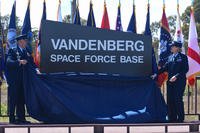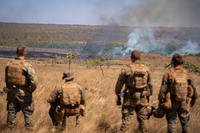The collision occurred in a dense fog bank several hundred yards west of the Golden Gate Bridge. The fully laden Arizona Standard was inbound en route to Richmond, Calif., and the Oregon Standard, carrying a full load of bunker fuel, was outbound steaming toward British Columbia. Both were T-2 tankships, 504 feet in length and 10,553 gross tons.
Before the Arizona Standard made its pass under the bridge, a red navigation light was sighted on the starboard bow of the Oregon standard, which was approximately 200 yards away. The master ordered a hard-left rudder and to stop all engines, but it was too late. The bow of the Arizona Standard penetrated the port side of the Oregon Standard at a 45-degree angle. The two vessels became locked together and 800,000 gallons of fuel spilled into the Bay Area waters.
The incident received national attention and resulted in two significant maritime safety initiatives: The Bridge to Bridge Radiotelephone Act and The Ports and Waterways Safety Act of 1972. The later allowed the Coast Guard the authority to construct, maintain and operate Vessel Traffic Service, which is now celebrating its 40-year anniversary.
The VTS is a Coast Guard unit that provides active monitoring and navigational advice for vessels in confined and busy waterways. The mission is to reduce vessel collisions and groundings in order to protect the environment from the release of petroleum and other hazardous cargos.
“We’re the eyes and ears for the Captain of the Port,” said Victor Zboralski, VTS Training Coordinator at VTS Puget Sound, located at Pier 36 on the Seattle waterfront. “We accomplish our mission by providing a measure of order and predictability on the water through active monitoring and advisory, traffic organization and navigational assistance services.”
VTS watchstanders use an array of sophisticated equipment that allows them a clear picture of the maritime traffic within their area of responsibility.
“We use a program called Coast Guard Vessel Traffic System which displays our area of responsibility as a chart with track icons for the different vessels we are tracking,” said Petty Officer 1st Class Gavin Shepherd, an operations specialist and watchstander at VTS Puget Sound. "These tracks are fed by radar, Automatic Identification System or both. The track icons are accurate to the vessel's location and display name and type of vessel, type of cargo on board, direction of movement and speed and any other pertinent information.”
“In higher traffic areas we use closed-circuit TV cameras which are fed to large screen monitors at our workstation,” said Shepherd. “All vessels participating with the VTS use a standard VHF-FM radio channel on which the operator can inform vessels of other vessel movement, navigational hazards, weather, marine events and fishing openings and can provide navigational assistance or any other information related to marine safety.”
Each watchstander has this technology at his or her fingertips, giving them a detailed look into the region’s maritime traffic.
“At our modal level, our comprehensive small scale view provides a complete snapshot of maritime activity, and we use this perspective to provide the mariner with timely information that allows for ample time to make their own sound navigational decisions,” said Zboralski.
To implement these services, the Coast Guard began establishing VTSs in critical, congested ports with the first two established in San Francisco and Seattle on Sept. 25, 1972.
The Coast Guard now operates 12 Vessel Traffic Centers throughout the United States including VTS Puget Sound. VTS Puget Sound monitors the Strait of Juan de Fuca, Rosario Strait, Admiralty Inlet and Puget Sound, maintaining an area of responsibility of more than 3,500 sq. miles, making it the largest in the United States.
VTS Puget Sound is also the nations’ only Vessel Traffic Center working cooperatively with the Canadian Coast Guard. Since 1979, VTS Puget Sound has worked directly with Tofino Marine Communications and Traffic Services, based in Ucluelet, B.C., and Victoria MCTS, located in Sidney, B.C., to monitor the waters of the Salish Sea, which includes the Strait of Juan de Fuca, the Puget Sound and the Strait of Georgia, and all their connecting channels and adjoining waterways. The three units cooperate via computer and dedicated telephone lines to advise each other of vessels passing between their areas of responsibility, allowing traffic to travel seamlessly in these multifaceted waterways.
"The cooperative vessel traffic service between the United States and Canada in managing vessel traffic plying the waters of the Pacific Northwest represents a hallmark of international cooperation,” said Capt. Scott Ferguson, Coast Guard Commander of Sector Puget Sound. “Fostering a robust safety, security, and environmental protection network has quietly provided extraordinary benefits for our joint citizenry."
In a typical year VTS Puget Sound monitors more than 220,000 vessel transits. They assist 150 search-and-rescue cases, 200 law enforcement cases and 30 pollution cases. They’re also able to affirm that their actions resulted in 55 marine accidents averted annually. Many of which involve large commercial tankers or freighters that could have devastating effects on the pristine environment of the Pacific Northwest.
“Imagine the convenience of steering your vessel, eyes on water, and having someone to assist as you navigate possibly unfamiliar waters,” said Zboralski. The VTS provides this type of security to commercial mariners. It’s similar to air traffic control in that regard; an eye in the sky if you will.
Technologically, a VTS can get by with radio communications only, which is known as “caveman style” in the watchstander lexicon; however, the addition of radar, AIS, and CCTV all enhance the effectiveness of a VTS service, which allows for safer marine transits and reduction in pollution to the environment that results from maritime mishaps.
“The Salish Sea is a pristine ecosystem and an important commercial port that deserves the best protection we can collectively muster,” said Zboralski. "Since the VTS has the best overall situational awareness of the real time maritime picture in the Northwest, it is hard to imagine who would have the bubble at their fingertips in our absence.”
Since the establishment of the VTS 40 years ago, commercial maritime transit has become safer and more predictable. The percentage of major maritime casualties has decreased significantly in areas monitored by Coast Guard VTS units and many accidents such as the Arizona Standard and Oregon Standard collision have been avoided. As we look forward, Coast Guard VTSs throughout the country will continue to keep an invariable eye on the nation’s congested ports and waterways with a mission of profound importance.

























